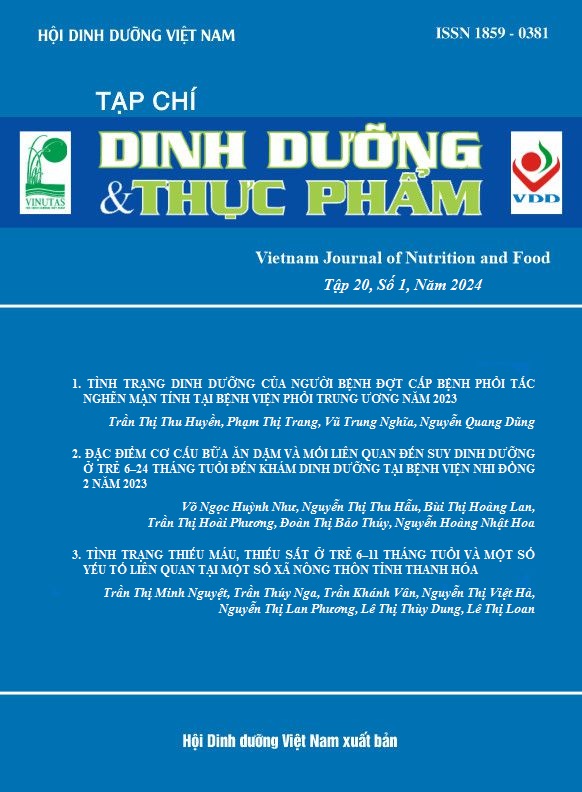NGHIÊN CỨU ỨNG DỤNG PROTEASE ĐỂ CHIẾT XUẤT PROTEIN THỦY PHÂN TỪ BÃ SỮA GẠO
Nội dung chính của bài viết
Tóm tắt
Mục tiêu: Xác định các thông số tối ưu cho quá trình chiết xuất protein từ bã sữa gạo đã làm sạch tinh bột và carbohydrate bằng enzyme protease thương phẩm
Phương pháp: Nghiên cứu được thực hiện trên cơ sở khảo sát lựa chọn 9 loại enzyme thương phẩm của công ty Amano-Nhật Bản để tiến hành tối ưu hóa điều kiện enyzme hóa nhằm chiết xuất protein từ bã sữa gạo bằng phương pháp thiết kế bề mặt RSM, mô hình I-optimal. Sản phẩm của nghiên cứu được phân tích SDS-PAGE để đánh giá thành phần protein.
Kết quả: Đã lựa chọn được enzyme protin “Amano” SD-AY10 của công ty Amano-Nhật Bản có hiệu suất chiết xuất protein và mức độ thủy phân DH cao nhất trong các enzyme được đánh giá. Quá trình tối ưu hóa điều kiện thủy phân bằng SD-AY10 cho hiệu suất chiết xuất protein từ bã sữa gạo đạt 90,1%, điều kiện tối ưu là: nồng độ enzyme :1.2%E S, nồng độ muối (NH4)2SO4 2.5%, pH 8, tại 60°C trong 120 phút thủy phân, khối lượng protein trong dịch thủy phân đạt 19,1%DS. Kết quả phân tích SDS-PAGE cho thấy sản phẩm có hàm lượng peptide phân tử lượng chủ yếu dưới 100 kDa, chứng tỏ sản phẩm có tính chức năng và chất lượng dinh dưỡng cao, phù hợp ứng dụng trong sản xuất các sản phẩm thực phẩm, mỹ phẩm, dược phẩm sử dụng cho con người.
Kết luận: Kết quả nghiên cứu giúp đa dạng hóa sản phẩm từ phụ phẩm nông nghiệp, đặc biệt là từ gạo, hỗ trợ phát triển cho ngành công nghiệp chế biến và sản xuất thực phẩm bền vững.
Từ khóa
Protein thủy phân, bã sữa gạo, protease, protin “Amano” SD-AY10, tối ưu
Chi tiết bài viết
Tài liệu tham khảo
2. Roy T, et al. Rice protein: Emerging insights of extraction, structural characteristics, functionality, and application in the food industry. Journal of Food Composition and Analysis. 2023:105581.
3. Zheng L, et al. Reconstituted rice protein: The raw materials, techniques and challenges. Trends in Food Science & Technology, 2023.
4. Charoen R, Tipkanon S, and Savedboworn W, Production of rice bran protein hydrolysates from traditional Thai rice bran (Plai-Ngahm-Prachinburi). International Food Research Journal. 2017;24:2304-2311.
5. Hamada JS. Use of proteases to enhance solubilization of rice bran proteins. Journal of Food Biochemistry, 1999;23:307-321.
6. Hanmoungjai P, Pyle DL, and Niranjan K. Enzyme-assisted water extraction of oil and protein from rice bran. Journal of Chemical Technology & Biotechnology: International Research in Process, Environmental & Clean Technology. 2002;77(7):771-776.
7. Morita T and Kiriyama S. Mass production method for rice protein isolate and nutritional evaluation. Journal of food science. 1993; 58(6):1393-1396.
8. Tang S, Hettiarachchy NS, and Shellhammer TH. Protein extraction from heat-stabilized defatted rice bran. 1. Physical processing and enzyme treatments. Journal of Agricultural and Food Chemistry. 2002;50(25):7444-7448.
9. Vo HT, et al, Optimization of Protein Hydrolysate Production from Defatted Rice Bran and Refining Process. 2017.
10. Lê Viết Hùng and H.Q. Tuấn, Nghiên cứu thu hồi protein trong bã gạo của quá trình sản xuất sữa gạo tại nhà máy Lavina food Công ty cổ phần mía đường Lam Sơn, in Viện Công nghệ sinh học và công nghệ thực phẩm. 2022, Đại học Bách Khoa Hà Nội: Đại học Bách Khoa Hà Nội.
11. Jiang Y, et al. Effects of salting-in/out-assisted extractions on structural, physicochemical and functional properties of Tenebrio molitor larvae protein isolates. Food chemistry. 2021;338:128158.
12. Pham T, et al. Effects of pH and Salt Concentration on Functional Properties of Pumpkin Seed Protein Fractions. Journal of Food Processing and Preservation. 2017;41.
13. Nielsen, P.M., D. Petersen, and C. Dambmann, Improved Method for Determining Food Protein Degree of Hydrolysis. Journal of Food Science. 2001; 66(5):642-646.
14. Jones CG, Daniel Hare J, and Compton SJ. Measuring plant protein with the Bradford assay : 1. Evaluation and standard method. J Chem Ecol. 1989;15(3):979-992.
15. Amagliani L, et al. Composition and protein profile analysis of rice protein ingredients. Journal of Food Composition and Analysis. 2017;59:18-26.
16. Gerzhova A, et al. Study of total dry matter and protein extraction from canola meal as affected by the pH, salt addition and use of zeta-potential/turbidimetry analysis to optimize the extraction conditions. Food chemistry. 2016;201:243-252.
17. Zhao Q, et al. Enzymatic hydrolysis of rice dreg protein: effects of enzyme type on the functional properties and antioxidant activities of recovered proteins. Food chemistry. 2012;134 3:1360-1367.
18. Charoen R, Tipkanon S, and Savedboworn W. Production of rice bran protein hydrolysates from traditional Thai rice bran (Plai-Ngahm-Prachinburi ). 2017.


